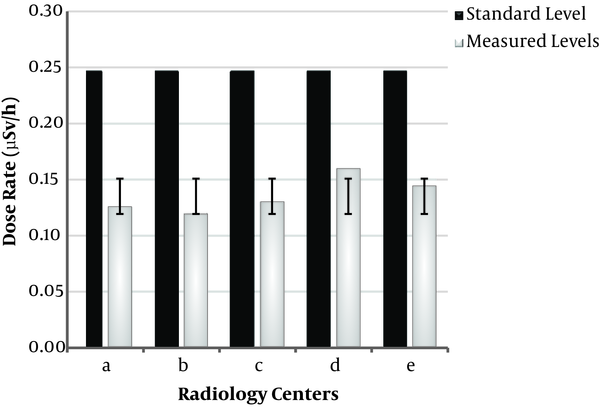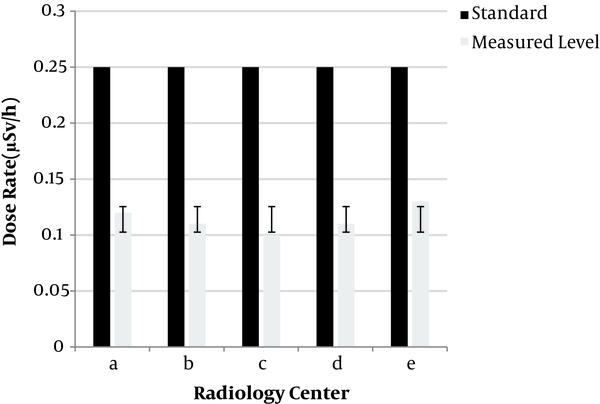1. Background
Generally, everyone can come into exposure to ionizing radiation found in the background, regardless of where he lives or works. Ionizing background radiation is present in the environment emitted from various sources (1). Generally, there are two main sources of ionizing radiation, natural sources and anthropogenic sources (1). As stated by the United Nations Scientific Committee on the Effects of Atomic Radiation (UNSCEAR), there are four main sources of natural radiation, including cosmic radiation and terrestrial radiation besides ingestion and inhalation of naturally occurring radionuclides. Radiation found in the background environment is the most important source of exposure for the general population. Human activities have gradually led to the increase of background ionizing radiation (2). Indoor background ionizing radiation is more important than outdoor background ionizing radiation because:
1. Some materials used in the construction contain radioactive elements.
2. Radon, a harmful radioactive gas, can be found in indoor air.
3. Generally, the time spent indoors is much more than the time spent outdoors.
The results of several studies by the World Health Organization (WHO) and the International Commission on Radiological Protection (ICRP) revealed that in a general time schedule basis, 80% of everybody’s time is spent indoors namely at offices, schools, homes, and inside different buildings (3) whereas the other 20% is spent outdoors.
Ionization radiation is used in medicine, research, and industry. It is used as a diagnostic and therapeutic tool to help people suffering from serious illnesses like cancer. Therefore, radiation is the main source of exposure for people in medicine and some related occupations. This has become of great concern regarding the well-established harmful impacts of high dosage of ionizing radiation occurring in hospitals and medical research centers. Patients can come into exposure to ionizing radiation through radiographic examination, radioisotope procedures, and therapies (4). Several studies have found evidence of injuries and symptoms caused by ionizing radiation (5). Some studies also demonstrated that chronic exposure to low doses of ionizing radiations is capable of inducing cytogenetic damage in the exposed person (6). Wall et al. showed that a linear growth of risk can be seen with an increase in exposure to ionizing radiation higher than the background level (7). Garaj-Vrhovac and Kopjar reported significantly higher DNA damage in exposed workers to ionizing radiation than in the control group (8). Therefore, with all this body of evidence, personal monitoring seems to be a vital part of any workers’ health protection program (9). Ionizing radiation has the power to destroy biomolecules and thus produce free radicals (10). Routine monitoring and assessment of the level of exposure to ionizing radiation are essential to keep the workers’ exposure as low as reasonably achievable (ALARA). A study evaluated background ionizing radiation in hospitals and radiology centers and measured ionizing radiation as 0.23 µSv/h and 0.28 µSv/h for outdoor and indoor, respectively (11). A study by Mettler et al. showed the mean background ionizing radiation level as 0.34 µSv/h (12). The mean value for the global natural dose of background ionizing radiation is reported as 0.27 µSv/h (13). Another study reported the background ionizing radiation level in a hospital at an average of 0.146 ± 0.02 μSv/h and 0.1413 ± 0.02 μSv/h for the indoor X-ray department and 0.136 ± 0.02 μSv/h inside the hospital building (14).
2. Objectives
In this study, we assessed the background ionizing radiation levels in radiology centers in Ahvaz to determine the risk of exposure to ionizing radiation.
3. Methods
A calibrated digital Geiger-Muller counter (S.E. International Inc., USA) was used for data collection. The range of doses measured by the detector was 0.01 μSv/h to 1000 μSv/h. The background radiation was measured both indoor and outdoor of the selected radiology centers in four locations. The measured locations included behind the door of the X-ray room, outdoor, waiting room for people, and the reception section in each center. The data were obtained by the gamma spectrometer oriented vertically upward. The data were obtained outdoors by the gamma spectrometer oriented vertically upward. When measuring, the device was held one meter above the floor. In total, 20 readings were taken to cover the areas adequately. The annual indoor and outdoor equivalent doses (mSv/y) were calculated by an equation developed by the UNSCEAR in 2000 (15). The data were analyzed with descriptive statistics and the one-sample t-test by SPSS V. 19. A P value of less than 0.05 was considered significant.
4. Results
The average indoor and outdoor equivalent doses are presented in Tables 1 and 2. Also, the annual equivalent dose was calculated for both indoor and outdoor in five radiology centers (Tables 1 and 2). The maximum permissible limit for non-radionuclide industrial employees and the public is 1 mSv/y as recommended by the ICRP (16). The average indoor equivalent doses in five centers are compared with the standard level in Figure 1. Figure 2 represents the comparison of the mean equivalent doses in various outdoor locations with the standard level. The results showed that the measured levels in indoor and outdoor of all centers were below the maximum permissible limit for the public.
| Radiography Center | Distance from X-Ray Room (m) | Mean Dose (µSv/h) | Minimum (µSv/h) | Maximum (µSv/h) | Annual Equivalent Dose (mSv/y) |
|---|---|---|---|---|---|
| a | 2 | 0.13 ± 0.004 | 0.10 | 0.15 | 0.49 ± 0.07 |
| b | 2 | 0.11 ± 0.004 | 0.08 | 0.14 | 0.42 ± 0.06 |
| c | 2 | 0.13 ± 0.004 | 0.11 | 0.17 | 0.49 ± 0.07 |
| d | 2.5 | 0.16 ± 0.007 | 0.11 | 0.21 | 0.58 ± 0.11 |
| e | 3 | 0.16 ± 0.006 | 0.12 | 0.21 | 0.58 ± 0.11 |
Mean Indoor Dose and Annual Equivalent Dose in Radiography Centers
| Radiography Center | Distance from X-Ray Room (m) | Mean Dose (µSv/h) | Minimum (µSv/h) | Maximum (µSv/h) | Annual Equivalent Dose (mSv/y) |
|---|---|---|---|---|---|
| a | 4 | 0.12 ± 0.02 | 0.06 | 0.55 | 0.11 ± 0.09 |
| b | 4 | 0.11 ± 0.01 | 0.01 | 0.20 | 0.10 ± 0.04 |
| c | 4 | 0.10 ± 0.01 | 0.06 | 0.14 | 0.10 ± 0.02 |
| d | 4.5 | 0.11 ± 0.01 | 0.09 | 0.19 | 0.11 ± 0.02 |
| e | 5 | 0.13 ± 0.01 | 0.12 | 0.16 | 0.12 ± 0.01 |
Mean Outdoor Dose and Annual Equivalent Dose in Radiography Centers
5. Discussion
In this study, we measured the indoor and outdoor mean equivalent doses and the annual equivalent doses of background ionizing radiation in five centers in Ahvaz, Iran. The results showed that the mean indoor equivalent doses of background ionizing radiation were maximum in the d and e centers with 0.16 ± 0.007 values while for outdoor, the e center had the maximum mean equivalent dose with 0.13 ± 0.00. The mean doses for both indoor and outdoor measurements were lower than the standard background radiation of 0.25 μSv/h. Also, the highest values for indoor and outdoor measurements were reported in the e center. The minimum mean equivalent doses obtained in indoor and outdoor areas belonged to the b and c centers. The mean equivalent doses were 0.11 ± 0.004 μSv/h and 0.10 ± 0.00 μSv/h for the b and c centers, respectively. These values were slightly higher than the values reported by Foulady et al. (17). It can be because radiology centers do not observe all protection measures correctly. Also, Cardis et al. reported that the medical doses showed a varying trend, which was dependent on technical factors that were ignored in the study (18). The results demonstrated that even the slightest defect in the structural design of the imaging room can lead to higher exposure levels. A study carried out by Adhikari et al. reported the importance of defects in the observed leakage (19). The minimum mean annual equivalent dose obtained in outdoor areas was 0.10 mSv/y and the maximum mean annual dose equivalent was 0.12 mSv/y; the corresponding results were 0.42 mSv/y and 0.58 mSv/y for indoor areas, respectively. In this study, the average annual equivalent doses (mSv/y) were lower than the threshold limit of 1 mSv/y in radiology centers that were similar to the results reported in other studies (14, 19, 20). It should be mentioned that there were some limitations in this study, including the weak cooperation of radiography centers during the study (only 5 out of 25 centers participated voluntarily in the present study) and the lack of knowledge of fundamental principles of X-ray machine layout and assembly in the department building.
5.1. Conclusions
In this study, background ionizing radiation levels were measured both indoor and outdoor in five centers of Ahvaz. The measurements were done in four locations in each center. The study showed that the mean equivalent dose and the annual equivalent dose were within the standard permissible limits set by the ICRP. Therefore, the radiology centers were safe in this regard.


